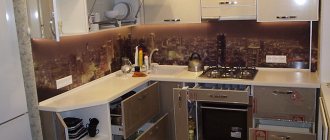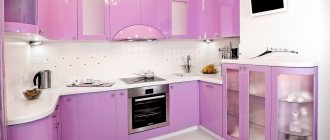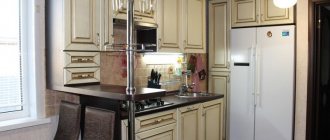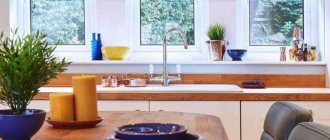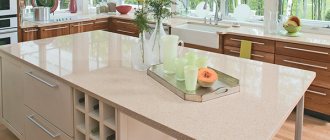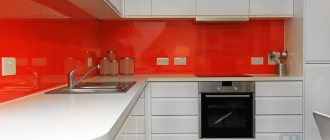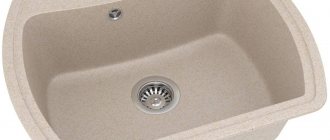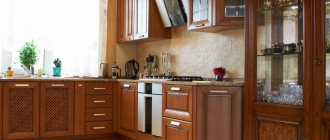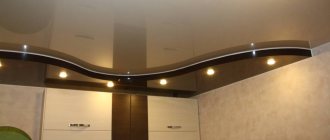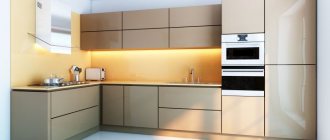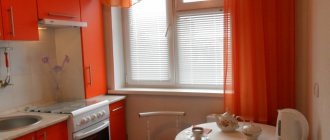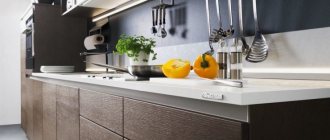Hi all! Currently, there are quite a lot of materials on the basis of which kitchen furniture is made. But they have a serious competitor. These are acrylic facades for the kitchen, which are gradually becoming more and more in demand and popular.
The material has excellent decorative properties. At the same time, it has high performance indicators.
There are several uses for this polymer material, which is a special high-quality type of plastic that shares some characteristics with glass.
Acrylic-based coating allows you to create interesting, original and unusual facades. But before you buy such furniture, you should look at its pros and cons. Still, the price per square meter is steep, and you need to be 100% confident in your decision.
What are acrylic facades?
At first glance it may seem that the panels are made of plastic. This is wrong. Thin MFD or chipboard panels are covered with special sheets of polymethacrylate, more often called acrylic.
MDF panels coated with acrylic.
This helps to ensure not only strength, which is important for furniture facades, but also wide design possibilities, as well as a characteristic glossy shine. MDF with acrylic coating is absolutely harmless, does not emit toxins when heated, and with proper care will last for many years.
High-gloss acrylic panels are easy to clean and do not fade over time. In addition, the properties of acryline help it not to absorb dirt and grease.
Floor and ceiling
The floor in a kitchen with matte furniture fronts should be made glossy. This will give the interior a certain style and add variety. In addition, it is advisable to make a matte ceiling.
However, some designers recommend decorating the ceiling with gloss to visually expand the space when the room is small.
Manufacturing technology of acrylic facades for kitchens
There are two ways to manufacture such facades: one-sided and two-sided. In the first case, the acrylic sheet is glued only to the outer part, leaving the inner part untreated. In the second, both sides of MDF or chipboard are glued, providing the doors with the same appearance from the inside and outside.
The coating is glued using a special glue (for example, Cosmofen or Akrifix), and then placed under a press. In this case, the sections are covered with a waterproof acrylic edge, which prevents peeling of the decorative layer. The thickness of such a facade often does not exceed 16-18 millimeters.
A more expensive option is solid acrylic panels up to four millimeters thick, edged with aluminum. Metal adds strength to them, comparable to chipboard, but they are much more difficult to maintain and are quite expensive.
Features of lighting in a matte kitchen
The surface of matte furniture does not reflect light, but scatters it. Therefore, with a lack of natural light and in small kitchens, interiors in dark colors look gloomy and heavy.
Artificial light improves the situation a little, but you should not hope for a warm and cozy atmosphere - for this it is better to choose light matte facades.
If the kitchen window faces the sunny side, then the matte facades are well lit, and the room does not look gloomy. In addition, there will be no glare from the sun in the kitchen, and the color of the facade will not be distorted.
In a kitchen with matte facades, powerful lighting should be provided in the main areas.
- Above the dining table is a chandelier with one or several bright bulbs.
- In the cooking area there are powerful lamps on the ceiling plus LED backlighting for the apron. Another option is a glass apron illuminated from the inside.
If necessary, cabinet lighting can be added using LED strips or additional lights on the ceiling. The kitchen will be visually more spacious if it has enough light sources.
Pros and cons of kitchens with acrylic facades
In addition to appearance and ease of installation, such facades have a number of advantages:
- Wear resistance. The strength of acrylic reliably protects it from damage due to impacts and scratches. In addition, damaged acrylic panels can be reconstructed to their original appearance. With proper care, they will last up to 20 years.
- Acrylic does not react to temperature changes and is resistant to heating up to 160 degrees. It does not deform when exposed to water, and does not fade from sunlight.
- Grease, soot and dust are not absorbed into the surface ; it can be easily cleaned with a simple detergent and a soft cloth. We recommend: Once every three to four months, treat facades with sprays that help maintain a glossy shine, for example, Weiss or Cosmofen.
- Large selection of design solutions. Acrylic panels are presented in a wide palette. In addition, you can decorate them with prints or airbrushing or decoupage.
- The glossy structure due to its reflective properties makes the room lighter and more spacious .
- Acrylic panels, unlike plastic ones, do not release toxic impurities into the air when heated. Therefore, acrylic can be considered an environmentally friendly material.
However, it was not without its drawbacks:
- Due to the manufacturing technology, acrylic facades are quite expensive . The cost of a solid acrylic facade can reach $600 per linear meter, and an acrylic coating can cost $100. At the same time, taking into account the quality, the price can be considered relatively affordable: the long service life fully pays for the costs of manufacturing and installation.
- The glossy surface is very difficult to handle. It does not scratch or chip, but any fingerprints and dust become much more noticeable. You will have to regularly wipe away streaks and stains. Please note: Special grease-repellent polishes will help prevent the problem.
- High shine. The disadvantage is conditional, but over time many people begin to be annoyed by the glossy mirror structure of the acrylic facade.
Still, traditional materials or acrylic?
To be fair, let's compare acrylic with other materials. It is believed that solid wood and veneer have the most presentable appearance. But acrylic kitchens stylized as wood look no less elegant - the photo eloquently confirms this:
In addition, acrylic better resists ultraviolet radiation and moisture, and at the same time costs much less than wood. This same advantage distinguishes it from enamel - when choosing acrylic, you save significantly. You could argue that plastic costs even less. This is true. But keep in mind: scratches appear more easily on a plastic surface, and in terms of wear resistance and durability it is much inferior to acrylic. If saving is so important to you, choose an acrylic kitchen finished not with panels, but with film.
What is better to choose for kitchen facades: acrylic or plastic?
As mentioned above, acrylic is much more environmentally friendly than plastic. But is this the only difference? We offer a comparative table of the two materials.
| Acrylic facades. | Plastic facades. | |
| Gloss. | Clearly expressed, with a mirror shine. | Compared to acrylic, plastic is duller. There are matte options. |
| Temperature resistance. | It tolerates heating up to 160 degrees without releasing toxic impurities. | Good HPL or CPL plastic can withstand temperatures up to 140 degrees, but cheap options begin to release toxins at 80 degrees, so they should not be placed near the stove. |
| Term of use. | With proper use - up to 20 years. | After just a couple of years, it may begin to fade from heat and direct sunlight. |
| Price. | High-quality acrylic will cost you quite a lot. | Affordable price. |
| Facade type. | Only deaf. | Deaf and radius. |
Let's summarize: Acrylic facades are more durable and reliable, but the price is not encouraging. At the same time, plastic facades are more affordable, but they are more capricious in everyday use and they cannot be placed next to heat sources.
Types of paints for the kitchen
The production of finishing materials does not stand still, and their composition is regularly improved. Thanks to the addition of various components - rubber base or polymers, excellent performance properties can be achieved.
Acrylic
A relatively inexpensive and versatile option, suitable for painting any surface - wood, concrete, plaster. It is better not to skimp on these coatings, since cheap acrylic paints will not last long.
Silicate
The main feature of this type is high vapor permeability and resistance to fungi. With such a coating, the walls will “breathe” and, if there is a high risk of mold in your home, this is the most suitable option.
Silicone
This type has high elasticity and excellent water-repellent properties, allowing you to hide small flaws and cracks that form when the house shrinks. It is convenient to work with this composition with a roller - the paint does not drip and penetrates well into hard-to-reach places.
Silicate and silicone paints are best suited for finishing a kitchen apron.
Latex
Thanks to the addition of latex, the paint has a more elastic, viscous structure and provides a more durable coating that can also be washed with abrasive agents. However, its cost will be higher. Latex paint is best used for textured surfaces.
Alkyd
Alkyds give a brighter and more saturated color than acrylics. However, they are also highly abrasion resistant and suitable for all surfaces.
What color should acrylic facades be made in?
The design palette for acrylic facades is extremely wide. Many colors and shades, the possibility of decorative design. We invite you to look at the most popular options among designers - perhaps you will find your ideal kitchen.
A white acrylic kitchen is a great choice for small spaces. Due to the color and glossy texture, it reflects light, visually enlarging the room and making it lighter and more spacious. However, keep in mind that such facades are very difficult to maintain - all the dirt and drops of grease are visible on the white surface, so you will have to wash the set often.
An interesting solution is a black and white acrylic kitchen . The classic combination looks very catchy thanks to the mirror shine. However, it is important to maintain a balance here: it is better if the colors are combined with each other, and do not overwhelm each other.
If such a combination seems boring to you, dilute it with another shade - it is better to choose bright colors, for example, pink, light green, blue.
Bright red is on trend right now, but we recommend being careful with it. Aggressive tones quickly tire the eyes, so monochromatic design in this case is not the best choice. Dilute it with calmer, pastel shades - beige, gray, golden.
The same applies to yellow kitchens. However, it all depends on the chosen tone. Soft colors will make the kitchen fresh and brighter, but bright colors require a muted edging.
A monochrome black kitchen is a bold but very stylish solution. It is important to pay attention to details: any inappropriate accessory, the slightest contamination - and the impression is ruined.
Which surface is better: glossy or matte
This question does not have a clear answer, since everyone has different tastes. Both options have both pros and cons. When choosing materials for kitchen finishing, it is important to analyze the shortcomings and decide what can be reconciled with and what is absolutely unacceptable. The result of such consideration will be the optimal answer to the question of which surfaces are best for a particular customer.
Matte furniture looks somewhat conservative. Glossy kitchens seem more modern and representative. The cooking room is an area of intensive use, which means it is not possible to protect it from various damages. The opinion that chips and scratches are more visible on a shiny surface is slightly exaggerated. Similar defects are also visible on matte facades, especially when it comes to the kitchen. The fact that dirt is less noticeable on matte surfaces does not eliminate the need for timely hygiene procedures. In some cases, such “disguise” can save you from embarrassment, but you will still have to take care of the room.
Matte kitchens are not the best option for small spaces. However, if you really want to use muted colors, they need to be successfully combined with glossy ones. For example, a shiny set harmonizes perfectly with a matte apron. This solution will allow you to realize the desire for soft light reflection and take advantage of the practical properties of finishing above the work area.
Both matte and glossy surfaces have the same right to use in kitchen decor. It is best if the owners choose the option that they prefer. In this case, being in the kitchen will not make them constantly regret that they followed the lead of outside advisers.
Manufacturers of acrylic kitchen facades
Acrylic panels are produced by dozens of manufacturers with very different pricing policies.
We offer you the TOP 3 manufacturers popular in Russia:
- Bel Viso using NIEMANN panels. Polish acrylic facades are one of the most famous. A wide selection of decorative designs, a huge color palette and high quality. The price, however, is appropriate - from $150 per linear meter.
- The Sidak company , located in the Leningrad region, will also not please you with the price tag - from $140 per meter. However, the factory goes through the full production cycle: from the panel to the finished facade, which affects the quality.
- Fordom is a more budget option. Turkish facades will cost you an average of $90 per meter. Of course, you can also find cheap acrylic facades. But be careful - most often the tempting price tag hides a low-quality coating or simple plastic, sometimes not even heat-resistant.
Easy to care for
Acrylic surfaces require absolutely no maintenance. Cleaning is carried out using special sprays and a soft dry cloth. This material has antistatic characteristics, so it does not collect dust and does not absorb kitchen grease.
The only nuance that should be taken into account is that for maintenance you should not use abrasives that can damage the surface. Twice a year it is recommended to treat the coating with a special spray that will prevent loss of shine.
Reviews from real owners of acrylic kitchens
If you look at the reviews of people who bought acrylic facades for their kitchen, you will notice one common point - everyone admires their beauty and durability, but emphasizes the capriciousness of their care. Most often, this means the need for regular cleaning.
However, some people think that wiping the facade once a month is enough, but the only disadvantage is the cost.
And some people don’t like the need to use special care products.
Sometimes a change in shade depending on the lighting is noted. Therefore, be careful with pastel colors - in the twilight they may appear dull.
However, the reviews are unanimous on one thing - acrylic facades are reliable, durable and beautiful.
Preferred interior styles for a matte kitchen
Matte textures with their formal and conservative appearance are suitable for classical styles such as baroque, country, and Provence. Modern designers use such materials even in high-tech and minimalist interiors. Also, matte facades will fit perfectly into a Scandinavian-style kitchen.
Country
Rustic materials and natural colors characteristic of country are embodied in matte textures. The facades are the color of different types of wood with a deliberately rough texture.
The shape of the facades is classic with cornices, glass windows and wooden handles. Colors: beige, light brown, light green. Countertops - made of natural or artificial stone.
Modern materials easily copy the antiquity and wear and tear of the Provence style. The facades are classic wood, with panels and glass inserts.
Light muted colors - lavender, olive, vanilla yellow and all wood tones. The lines are simple, the shapes are round.
Countertops - made of stone and wood, natural or imitation. It is recommended to choose a tabletop with a glossy texture, using it as an accent.
Classic style
Classic is restraint and elegance. Lightness is not needed here, everything should be monumental. Matte furniture will do this perfectly. Natural shades - white, beige, brown. The facades are paneled, the handles are metal, antique.
Loft
Matt kitchens are suitable for loft style, where there are no restrictions on materials and colors. Here you can use coatings with textures like stone, marble, leather and fabric, as well as large patterns on facades made by photo printing.
How to care for acrylic facades
As can be seen from the reviews, the main problem with acrylic facades is their maintenance. How to properly care for the panels?
Now we'll tell you:
- Do not use aggressive abrasive detergents.
- When choosing what to wash the panel with, stick to the mildest possible detergents - for example, regular dishwashing detergent.
- Use lint-free soft cloths.
- Wipe the surface regularly to prevent fingerprints and dirt from accumulating on it.
- Use polish for acrylic kitchen facades - it will make cleaning much easier.
Let's summarize: With proper care, an acrylic facade is an excellent choice for kitchen design. A beautiful, eco-friendly and durable set will become a real decoration of the room. Among the disadvantages, we note the high price - however, taking into account the durability of such furniture, it is completely justified.
Color palette: matte in different tones
The impression a matte kitchen will make largely depends on the correct color selection. For example, in small kitchens it is better to avoid dark or too colorful sets - they will visually make the room even smaller. Light, pastel colors, on the contrary, will help expand it or make the walls taller. Let's see what matte kitchens look like in different shades.
The classic option is white sets with matte panels. It is well suited for both small and spacious kitchens. However, keep in mind that it is quite difficult to care for it - all the dirt is visible on the white one.
A more practical solution is a white matte kitchen with black countertops. This way, less cleaning will be required, and such headsets look very stylish.
In high-tech kitchens, the combined option looks good. For example, black bottom and white top.
Idea: If you want to add color, make the bottom part bright - lemon, light green, orange. The advantage of white is that it matches the entire palette.
For classic interiors, choose restrained tones - beige, brown, gray. Matte wenge kitchens and other wood-look options look beautiful. If your budget allows, consider a set made of solid wood, coated with a special matte water-repellent impregnation.
Black matte kitchens are quite capricious. Caring for them is almost as difficult as glossy ones. Therefore, think carefully about whether you can maintain order. But they look very stylish.
Matte kitchens in bright colors look very unusual: red, indigo, yellow, green. The palette of shades is quite wide, so choose a color based on the overall interior of the kitchen.
More restrained options - lavender, blue, light purple - will suit Provence or country styles. It is important to choose the right combination of colors so as not to spoil the design idea.
If monochromatic kitchens seem boring to you, try combining shades. Follow the general rules of color selection: the combination should not irritate the eye and not be too pretentious.
Monochrome sets with a contrasting or printed apron look good.
The design can also be applied to the set itself. The variety of prints allows you to choose a picture to suit any style, so the choice is yours: fruits, berries, spices, landscapes or abstraction. However, it is important to maintain a sense of proportion here: in a small kitchen, subtle applications or patterns look good, in large ones you can afford a full-scale painting.
Kitchens with acrylic facades photo examples
Apron
Modern aprons are made not only from ceramics: manufacturers often use MDF, PVC, acrylic, wood, mosaic, metal and glass. Products made from natural and artificial stone are also popular. An apron can become a bright accent when decorating a kitchen in calm, neutral shades.
On the contrary, bright facades go well with aprons in soothing colors. Acrylic aprons look great in the interior in tandem with sets made of a similar material: glossy, matte, transparent or with photo printing.
Note!
Kitchen in light colors - overview of interiors in loft, hi-tech, minimalism and Scandinavian styles (photo + video)Photo wallpaper for a children's room: rules for choosing, recommendations for combination, photo and video tips for a boy's and girl's room
- How to choose the right washable wallpaper for the kitchen: video instructions, tips and recommendations from craftsmen and designers
